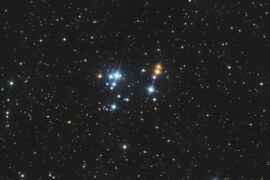Figuring out how to locate constellation in the night sky with just your eyes is really fun. Not only is it a great party trick for when you go camping with friends or family, but it also helps you train your visual pattern recognition abilities.
In this article, we will help you figure out how to find one of the most elusive constellations: Aquarius, also known as the water-bearer.
Finding Aquarius can be tricky for the untrained stargazer because of two reasons:
- It does not contain any stars that are really bright. It’s brightest star, Sadalmelik only has a magnitude of 2.9. For comparison, the brightest stars like Sirius, or Betelgeuse have a magnitude below 1 (Less is better when it comes to magnitude).
- It is not located near other easily recognizable constellations.
- The shape of the constellation is nothing that really stands out.
Still, let’s take on the challenge and go find it. First things first.
When is the Aquarius Constellation Visible in The Sky
Aquarius can be found almost all year long, from April to January, but the best time to watch it in the Northern Hemisphere is between October and November when it’s highest in the sky.
From mid-February to mid-March, Aquarius is directly positioned behind the Sun, making it impossible to observe it during those weeks.
When the Sun is the zodiac sign of Aquarius, from January 20 to February 19, the constellation can be really hard to locate and it might not be visible at all in some locations.
Where to Find the Aquarius Constellation
In the Northern Hemisphere (USA, Canada, UK, and the rest of Europe), Aquarius can be found in the southern sky.
On the other hand, if you are in the Southern Hemisphere, in Australia, New Zealand, or Argentina, Aquarius will be found either in the Northern sky, or directly overhead, depending on the month of the year.
How to Find the Aquarius Constellation
Here comes the tricky part. As I mentioned earlier, this is one of the hardest constellations to find with the naked eye because of its lack of recognizable features, but here are some tips and instructions that will help. Thankfully, there are a few factors we can use to our advantage.
Find dark skies and clear weather
Good sky conditions are going to be key in our quest to find the location of this star group. As you might know, the city lights create and effect called light pollution, that dims the visibility of certain stars in the sky.
A cloudy sky, is also not a good friend of astronomers. When you are trying to star gaze, dark skies, and clear weather will give you the best chance to have a great experience.
Find the zodiac ecliptic
The ecliptic is the imaginary line the Sun passes by throughout during the course of a year. It is in this path that the zodiac constellations can be found. This is of great help when you are trying to locate any of the harder to find constellations as you can simply trace it in your mind to help you get a better idea of where any of these 12 constellations should be positioned.
Finding the ecliptic is pretty simple, but it can take a bit of time and patience. There are ways to find with an app on your phone, but where’s the fun in that?
The best moment to find it is at sunset. Then do the following:
- Locate where the Sun is setting. This is West. You will see a bright object that you might confuse with a star near the Sun. This is actually Venus. Note its position.
- Look to the opposite direction, where the Moon is starting to rise. This direction is East(ish).
- Trace an imaginary line between the Moon and Venus. That is the ecliptic. At least close enough to it as it is not 100% exact.
- If you want confirmation, you can also wait two hours after sunset and try to find Mars. The ecliptic also passes close to it.

Find Capricornus
One of the most common tricks to find constellations that are harder to recognize, is to simply look for neighbors that are easier to find and go from there.
In the case of Aquarius, we are going to use Capricornus to locate it.
Once you have located the ecliptic, Capricornus should be easy to recognize. It has a very recognizable boomerang/triangle shape and it contains brighter stars. The ecliptic plane passes right through it. As we mentioned previously if you are somewhere in the Northern Hemisphere, like in the US, look to the South while following the ecliptic /zodiac line.

Find the Y shaped Aquarius stars
Perhaps the most recognizable feature in Aquarius is a small group of three stars shaped like a Y formed by the stars Alpha Aquarii, Zeta Aquarii, and Gamma Aquarii. Once you have found Capricornus, simply look around for this group of stars. From there you should be able to trace the rest of Aquarius. The following illustration should help.

Congratulations! you have reached your goal.
Since you are already in the area, you can also try to find the Pisces constellation opposite to Capricornus. It is small, but it shouldn’t be too hard to find now that you have so many reference points.

If that doesn’t work: Getting some help to locate constellations
It’s ok if you are still having trouble finding your way to Aquarius, there are a some ways you can get some visual help.
The easiest way is to pick up a star map. These are printables with a circular view of the night sky. The position of the stars changes throughout the year, so in order to help you locate the stars you are looking for, the most complete star maps, let you set your current date and show you the position of the constellations at that point in time. Here’s a good star map that you can pick up on Amazon for the Northern latitudes. It works for the US, Canada, UK, and Europe. If you live in the Southern Hemisphere, there are equivalent versions.
Here’s another option, it’s a lot prettier, and can even be used as wall art, but it doesn’t have all the date tools.
How to find more constellations
Aries – Taurus – Gemini – Cancer – Leo – Virgo – Libra – Scorpius – Saggitarius – Capricornus – Aquarius – Pisces
Enjoyed this article?
Get daily 10-minute PDFs about astronomy to read before bed!
Sign up for our upcoming micro-learning service where you will learn something new about space and beyond every day while winding down.







